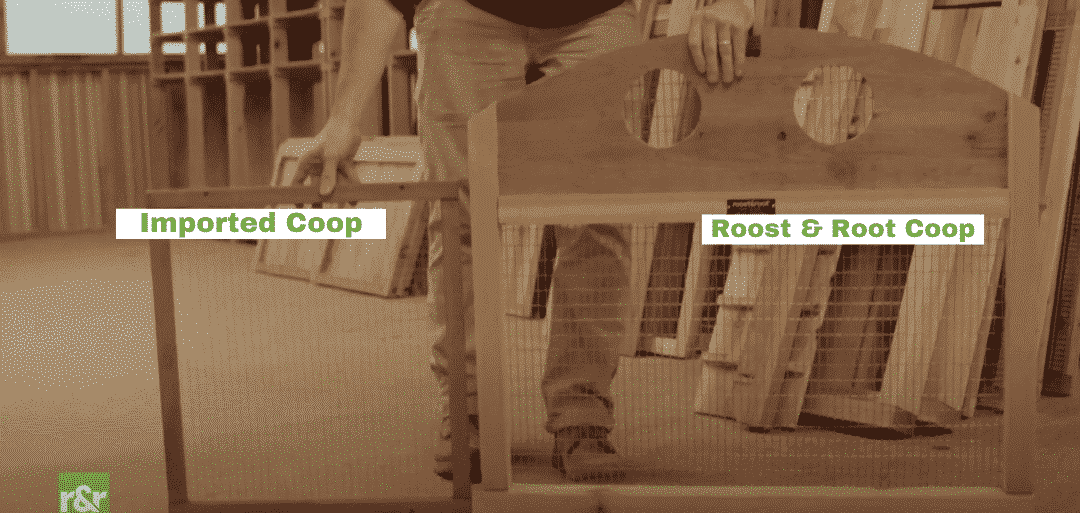
Are you considering investing in your very first chicken coop or perhaps a new coop? If so, you may find plenty of cheap coops at big box stores. At the time, these low-priced coops may seem like a bargain…but they never remain a bargain for long. Before you choose your flock’s future home, consider a few of the following reasons why we don’t recommend a cheap chicken coop.
1) Quality
If there is one material that you don’t want to skimp on, it’s the construction material of your coop. The lack of quality in imported chicken coops is why their lifetime never lasts long. Simply because a coop refers to using “real wood” doesn’t always mean it’s an ideal and great wood. Cheap chicken coops will always use flimsy, easily warped, thin wood that can effortlessly be damaged, regardless of being advertised as weather-resistant, these coops will eventually split. Most cheap coops are built with a thin sheet of softwood known as fir, which is far less resistant to decay and wet conditions. Often, big-box store brand coops will have a maximum lifetime of 2 years or less, regardless of the outside elements.
What we Recommend:
Cedar is known as one of the most rot and weather-resistant woods available. Commonly used for outdoor construction such as decks, cedar is made to withstand harsh outside elements. This wood, however, does come at a premium due to its sought-after qualities. A Cedarwood coop will last outdoors up to 5x longer than your average “bargain” coop. For more information on why we recommend cedar, visit our blog post here!
2) Customer Support
Nobody enjoys being left on hold while requesting help from a company. Even when you are able to reach someone finally, the aid you receive tends to be limited. At large brick-and-mortar stores, the staff does not know much about chicken-keeping. Even worse, they often don’t know much about the products they sell! It’s likely that if you order a bargain coop that needs missing or replacement parts, you’re better off fixing it yourself, buying an entirely new coop, or dealing with a return!
3) Safety
A majority of “bargain” chicken coops weigh between 50 to 85 pounds, all unevenly distributed from the nest/roost to the run area. In most cases, these coops can easily be knocked over or shaken up on a windy day. Even worse, a coop under 85 pounds can easily be knocked over by a large and curious pet. When you add in the fragility of the fir wood with the low-cost wire enclosure, your birds are susceptible to a number of unexpected or accidental dangers.
4) Comfort & Ease of Use
Small bargain coops tend to be constructed narrowly leaving little space for your growing birds as they mature. In addition, adding your bird’s waterer and feeder will only take up what little run space your birds have.
When it comes to the nest box of these coops, there is little privacy for your birds to lay in comfort as most are not separated and enclosed from the roost bars. When it comes to the roost bars of these small coops, most are in level with that of the nest box. Roost bars should always be placed higher than the nest box or else your birds will sleep in and leave droppings in the nest box instead.
5) No Climate Consideration
Winter:
Many of your commonly seen bargain coops won’t come prepared with additional instructions or parts to protect your birds during winter or heavily forecasted rain. You will likely find yourself constructing additional pieces to shield the elements or even using a tarp with the hope that your birds remain comfortable and dry.
Summer:
If you live in a state prone to receiving triple-digit weather forecasts, your birds will need a coop that distributes as much heat away from the coop. In addition, you will need a ventilation system that allows adequate airflow all day. Most cheap coops come with an asphalt-like roof that can be hot to the touch. It’s for this reason that we always use galvanized roof metal to reflects heat. Unlike asphalt, galvanized metal stays cool to the touch and reflects heat away, even on the hottest of days.
6) Ventilation
Ventilation is by far one of the most important features of a coop. Birds will need adequate ventilation near their roosting space to prevent heat exhaustion as well as frostbite. In addition, adequate ventilation will allow for easier and more bearable coop clean-ups. Live in an area that experiences a majority of the year with warm temperatures? You’ll want a coop that isn’t fully enclosed in wood to prevent any overheating.
We hope you find our blog post helpful as you consider your flock’s future home. Remember, although cheaper, the quality of a coop will always show through the price. For help in learning more about backyard chicken keeping, make sure to visit our other blog posts. Have a question regarding what was mentioned in this article? Reach out to us, we’re real people and enjoy helping new and existing chicken and coop owners everywhere! support@roostandroot.com, phone: 877-741-2667.
Interested in reading more? Check out our article 10 reasons Round-Top Chicken Coops™ are worth more….


